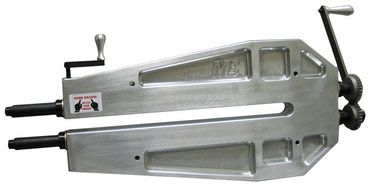Difference between revisions of "Bead Roller"
Jump to navigation
Jump to search
| Line 33: | Line 33: | ||
#Begin by tracing the area of your desired bead on the sheet metal. | #Begin by tracing the area of your desired bead on the sheet metal. | ||
#Next, loosen the tensioning bolt, and place the sheet metal between the two forming dies. | #Next, loosen the tensioning bolt, and place the sheet metal between the two forming dies. | ||
| − | #Tighten the tensioning bolt by turning it two revolutions after both dies contact the sheet metal. | + | #Tighten the tensioning bolt by turning it two revolutions after both dies contact the sheet metal. Make sure the sheet metal is contacting the traced line where you would like the bead to begin. |
# Turn the handle on the opposite side as you guide the metal through the dies. It may be easier to have a second person do this to allow the first person to more accurately guide the sheet metal through the beads. | # Turn the handle on the opposite side as you guide the metal through the dies. It may be easier to have a second person do this to allow the first person to more accurately guide the sheet metal through the beads. | ||
# | # | ||
Revision as of 14:29, 16 March 2019
A bead roller is a type of roller used for forming and reinforcing sheet metal. Sheet metal is rolled between two beads (or other dies) to give it extra strength and rigidity. The bead roller in the shop is the Mittler 210-24M.
The current Ace of the Bead Roller is Needed (Makerhub@georgefox.edu).
Documentation
Resources
- Video showing the bead rolling process.
Training
Rolling Steps
- Begin by tracing the area of your desired bead on the sheet metal.
- Next, loosen the tensioning bolt, and place the sheet metal between the two forming dies.
- Tighten the tensioning bolt by turning it two revolutions after both dies contact the sheet metal. Make sure the sheet metal is contacting the traced line where you would like the bead to begin.
- Turn the handle on the opposite side as you guide the metal through the dies. It may be easier to have a second person do this to allow the first person to more accurately guide the sheet metal through the beads.
Maximum Capacity
- 19 Ga (.040”) Mild Steel
- 16 Ga (.050”) Aluminum
- 21 Ga (.035”) Stainless
